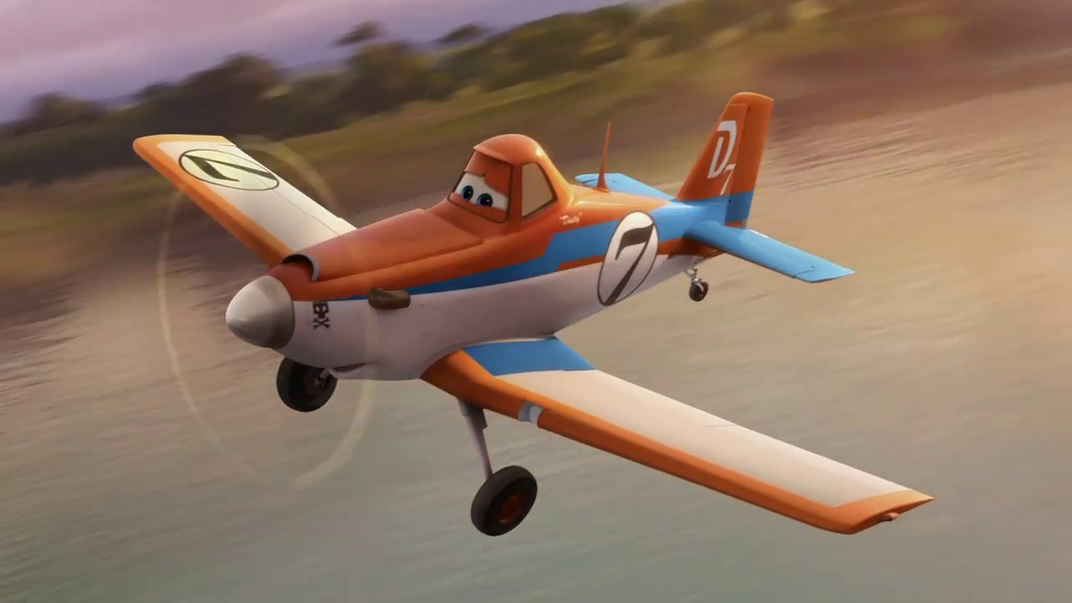Disney’s Dusty Crophopper—the Little Airplane that Could—Comes to the Smithsonian
Iconic Air Tractor aircraft on display at the Udvar-Hazy Center this Saturday
/https://tf-cmsv2-smithsonianmag-media.s3.amazonaws.com/filer/f4/2d/f42d2142-d862-4e59-9cf6-3ff633f78e47/rustys-dusty-in-flight_ed.jpg)
Buckle up! It’s going to be “Dusty” time at the Innovations in Flight Family Day and Aviation Display this Saturday, August 21. Dusty Crophopper—the star of Disney’s 2013 movie Planes—will be outdoors on the tarmac at the Steven F. Udvar-Hazy Center in Chantilly, Virginia, for this annual fly-in and aviation show. At the request of Disneytoon Studios, this Air Tractor AT-301/400A was fixed up to look like the Disney animated aircraft that had high-flying aspirations of competing as an air racer. The aircraft became a hit at air shows over the past eight years, following the success of the first film and its 2014 sequel Planes: Fire and Rescue.
“It’s here, and it’s part of our collection,” says Dorothy Cochrane, a curator at the Smithsonian’s National Air and Space Museum. “Dusty flew in a couple of weeks ago. All we had to do was wash it and put it out for the public to see.”
The aircraft was donated by Rusty Lindeman of Rusty’s Flying Service, an agricultural aviation company based in Texas. “Rusty flew the plane to Chantilly from Texas,” Cochrane says. “He has a fleet of aircraft for agricultural and other industrial applications. It has been a working plane for years.”
Developed by Air Tractor, the AT-301/400A is considered the workhorse of commercial aviation. Though used primarily for agricultural purposes, the airplane is also utilized by other sectors, including firefighting and insect control.

Crop-dusting has been an aerial industry for 100 years. Surplus biplane aircraft were first used shortly after World War I to help farmers improve harvests by delivering fertilizer and pesticides in targeted applications. The idea of itinerant pilots soaring over farm fields fueled the imaginations of many people during the era when aviation was just taking hold.
The industry continued to evolve with better and safer aircraft models. In 1973, Air Tractor founder Leland Snow came up with the revolutionary design for the first AT-301. Its sleek design, long wings and powerful engine provided the plane with incredible agility for the precision tight turns and deep dives needed for accurate agricultural applications. This 301 model was later upgraded with a turbine engine to become a 400A. Newer Air Tractor models have since replaced the aircraft. While no longer in production, the AT-301/400A is still valued by the industry for its versatility.
In many ways, this agricultural aircraft is the little plane that could. In real life and in the film, it exceeds expectations, proving that limitations are often just preconceptions.
In Planes, Dusty Crophopper accidentally gets a taste of revved-up racing fuel and decides he wants to fly in air competitions. Along the way, he learns about himself and discovers his success helps others up their games. In one scene, a friend tells Dusty how he is an inspiration to all the aircraft. The Air Tractor is puzzled by the comment, so the other plane adds: “Yeah, all of us who want to do more than just what we are built for”—a fitting honor for the adaptable aircraft.
“The Air Tractor is the most-used agricultural aircraft,” says Cochrane, who is the curator of the upcoming “We All Fly Gallery,” which opens in the fall of 2022 after the museum completes its massive renovation. “Firefighters have used it for years because they can make small precision drops with it. It’s the perfect plane.”
“We All Fly” celebrates the breadth and depth of general aviation and its deep impact on society. The gallery explores the many facets of general aviation—from sport to business to humanitarian—and introduces the variety of careers available in aviation. Aircraft featured in the gallery include the ASU Challenger III, Cirrus SR22 and Lear Jet 23.
Arranged by the National Agricultural Aviation Association, Lindeman’s donation of the aircraft to the Smithsonian is part of a commemoration of the 100th anniversary of agricultural aviation.
Visitors can see Dusty for the first time at the Smithsonian during Innovations in Flight Family Day on August 21. Admission is free but tickets are required. There is a $15 fee for parking. The outdoor aviation display will be held 10 a.m. to 3 p.m. on Saturday at the National Air and Space Museum’s Steven F. Udvar-Hazy Center in Chantilly, Virginia, near Washington Dulles International Airport.
/https://tf-cmsv2-smithsonianmag-media.s3.amazonaws.com/accounts/headshot/dave.png)


/https://tf-cmsv2-smithsonianmag-media.s3.amazonaws.com/accounts/headshot/dave.png)